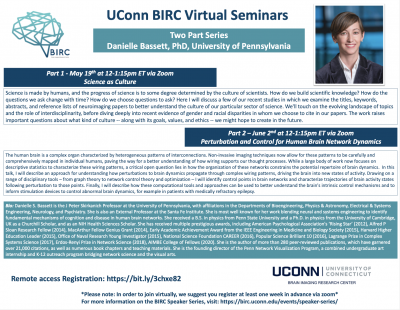Congratulations to two teams of IBRAiN (IBACS-BIRC Research Assistantships in Neuroimaging) graduate students (Yanina Prystauka, Emily Yearling, and Xu Zhang; Charles Davis and Monica Li) on their contribution to a recent study that examined variability in the analysis of neuroimaging data.
The scientific process involves many steps, such as developing a theory, creating hypotheses, collecting data and analyzing the data. Each of these steps can potentially affect the final conclusions, but to what extent? For example, will different researchers reach different conclusions based on the same data and hypotheses? In the Neuroimaging Analysis, Replication and Prediction Study (NARPS) almost 200 researchers (from fields including neuroscience, psychology, statistics, and economics) teamed up to estimate how variable the findings of brain imaging research are as a result of researchers’ choices about how to analyze the data. The project was spearheaded by Dr. Rotem Botvinik-Nezer (formerly a PhD student at Tel Aviv University and now a postdoctoral researcher at Dartmouth College) and her mentor Dr. Tom Schonberg from Tel Aviv University, along with Dr. Russell Poldrack from Stanford University.
First, a brain imaging dataset was collected from 108 participants performing a monetary decision-making task at the Strauss imaging center at Tel Aviv University. The data were then distributed to 70 analysis teams from across the world. Each team independently analyzed the same data, using their standard analysis methods to test the same 9 pre-defined hypotheses. Each of these hypotheses asked whether activity in a particular part of the brain would change in relation to some aspect of the decisions that the participants made, such as how much money they could win or lose on each decision.
The analysis teams were given up to 3 months to analyze the data, after which they reported both final outcomes for the hypotheses as well as detailed information on the way they analyzed the data and intermediate statistical results. The fraction of analysis teams reporting a statistically significant outcome for each hypothesis varied substantially; for 5 of the hypotheses there was substantial disagreement, with 20-40% of the analysis teams reporting a statistically significant result. The other 4 hypotheses showed more consistency across analysis teams. Interestingly, the underlying statistical brain maps were more similar across analysis teams than expected based on the diverse results from the final hypothesis tests. Hence, even very similar intermediate results led to different outcomes across analysis teams. In addition, a meta-analysis (combining data across experiments, or in this case across analysis teams, in order to analyze them together) that was performed on the analysis teams’ intermediate results showed convergence across teams for most hypotheses. The data did not allow testing of all of the factors related to variability, but some aspects of the analysis procedures were found to lead to more or fewer positive results.
A group of leading economists and behavioral finance experts provided the initial impetus for the project and led the prediction market part of the project: Dr. Juergen Huber, Dr. Michael Kirchler and Dr. Felix Holzmeister from the University of Innsbruck, Dr. Anna Dreber and Dr. Magnus Johannesson from the Stockholm School of Economics and Dr. Colin Camerer from the California Institute of Technology. Prediction markets are a tool that provides participants with real money they can then invest in a market – in this case, a market for the outcomes on each of the nine tested scientific hypotheses. Here, they were used to test whether researchers in the field could predict the results. The prediction markets revealed that researchers in the field were over-optimistic regarding the likelihood of significant results, even if they had analyzed the data themselves.
The researchers emphasize the importance of transparency and data and code sharing, and indeed all analyses in this paper are fully reproducible with openly available computer code and data.
The results of NARPS show for the first time that there is considerable variance when the same complex neuroimaging dataset is analyzed with different analysis pipelines to test the same hypotheses. This should certainly raise awareness for members of the neuroimaging research community, as well as for every other field with complex analysis procedures where researchers have to make many choices about how to analyze the data. However, at the same time, the findings that the underlying statistical maps are relatively consistent across groups, and meta-analyses led to more convergent results, suggest ways to improve research.
Importantly, the fact that almost 200 individuals were each willing to put tens or hundreds of hours into such a critical self-assessment demonstrates the strong dedication of scientists in this field to assessing and improving the quality of data analyses.
The scientific community aims constantly to gain knowledge about human behavior and the physical world. Studying such complex processes frequently requires complex methods, big data and complex analyses. The variability in outcomes demonstrated in this study is an inherent part of the complex process of obtaining scientific results, and we must understand it in order to know how to tackle it. As the recent COVID-19 pandemic made clear, even when taking into account the uncertainty inherent to the scientific process, there is no substitute for the self-correcting scientific method to allow the global human society to address the challenges we are facing.
The CT Institute for the Brain and Cognitive Sciences (IBaCS) offers IBACS-BIRC Research Assistantships in Neuroimaging (IBRAiN). After formal training, IBRAiN fellows provide a teaching resource to help BIRC users design and implement experimental procedures for fMRI, EEG, TMS and other methodologies, provide resources for data analysis, and oversee use of equipment by others. Click here for more information about applying to this program.
